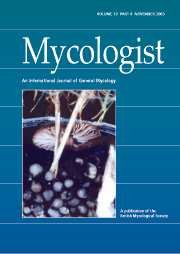Crossref Citations
This article has been cited by the following publications. This list is generated based on data provided by
Crossref.
Peterson, Robyn
Grinyer, Jasmine
Joss, Janice
Khan, Alamgir
and
Nevalainen, Helena
2009.
Fungal proteins with mannanase activity identified directly from a Congo Red stained zymogram by mass spectrometry.
Journal of Microbiological Methods,
Vol. 79,
Issue. 3,
p.
374.
Peterson, Robyn
Grinyer, Jasmine
and
Nevalainen, Helena
2011.
Extracellular hydrolase profiles of fungi isolated from koala faeces invite biotechnological interest.
Mycological Progress,
Vol. 10,
Issue. 2,
p.
207.
Dojnov, Biljana
and
Vujčić, Zoran
2012.
Fast and reliable method for simultaneous zymographic detection of glucoamylase and α-amylase in fungal fermentation.
Analytical Biochemistry,
Vol. 421,
Issue. 2,
p.
802.
Liu, Jingjing
Chen, Jingyu
Fan, Yi
Huang, Xiaoning
and
Han, Beizhong
2018.
Biochemical characterisation and dominance of different hydrolases in different types of Daqu – a Chinese industrial fermentation starter.
Journal of the Science of Food and Agriculture,
Vol. 98,
Issue. 1,
p.
113.
Mohamed, Elsayed
Kasem, Ahmed M.M.
and
Farghali, Kotb A.
2018.
Seed germination of Egyptian Pancratium maritimum under salinity with regard to cytology, antioxidant and reserve mobilization enzymes, and seed anatomy.
Flora,
Vol. 242,
Issue. ,
p.
120.
Aggarwal, Ruchika
Dutta, Tanmay
and
Sheikh, Javed
2019.
Extraction of amylase from the microorganism isolated from textile mill effluent vis a vis desizing of cotton.
Sustainable Chemistry and Pharmacy,
Vol. 14,
Issue. ,
p.
100178.
Shruthi, Balakrishna Rao
Achur, Rajeshwara Nagappa Hegde
and
Nayaka Boramuthi, Thippeswamy
2020.
Optimized Solid-State Fermentation Medium Enhances the Multienzymes Production from Penicillium citrinum and Aspergillus clavatus.
Current Microbiology,
Vol. 77,
Issue. 9,
p.
2192.
Magalhães, Ana Carolina Martins
de Santana, Carlos José Correia
Melani, Rafael D.
Domont, Gilberto B.
Castro, Mariana S.
Fontes, Wagner
Roepstorff, Peter
and
Júnior, Osmindo Rodrigues Pires
2021.
Exploring the biological activities and proteome of Brazilian scorpion Rhopalurus agamemnon venom.
Journal of Proteomics,
Vol. 237,
Issue. ,
p.
104119.
Silva-Salinas, Anaid
Rodríguez-Delgado, Melissa
Gómez-Treviño, Jesús
López-Chuken, Ulrico
Olvera-Carranza, Clarita
and
Blanco-Gámez, Edgar Allan
2021.
Novel Thermotolerant Amylase from Bacillus licheniformis Strain LB04: Purification, Characterization and Agar-Agarose.
Microorganisms,
Vol. 9,
Issue. 9,
p.
1857.




